I’m over to catch up with Simon Nunns for a chat to see what he’s up to. Last time I bumped into him he described himself as ‘making chutney’, but I haven’t been to his home, so I’m not sure if I should expect a place overflowing with exotic spices and vegetables.. In fact it’s a striking mid-century house with suitable ‘cool’ fittings and an impressive looking hi-fi set up.
I see you like your music – that’s quite an impressive set up. I’m finding quite good buying in the CDs at the moment. I think the days of picking up good vinyl for cheap have gone, but I’m still finding I can get CDs for around a dollar each. I’ve still got the Sony CD player I bought in a HiFi shop in Bristol about 30 years ago. I remember deliberately talking to the people there and saying I wanted a good one that had the fewest ‘features’ possible. I think this one has Play, Pause, Stop, Shuffle and a thing called ‘Time’ where it plays the CD but counts down the time on each track – not hugely useful, or used. I was at a fleamarket a couple of days ago and this one guy had the most boxes of CDs I’ve ever seen. He must have had 5000 CDs, and that’s all he had. No – he had two ladders as well. I mean looking through one banana box of CDs is fine, but he had about fifty boxes. It was daunting, and plenty of weird stuff, not just pop music.
Simon Nunns: I agree, it’s daunting, to have that much choice. I’ve taken to, when I’m buying vinyl now, making up a list of what I’m interested for the day. And that might be ten albums, and not deviate too much from that. So it gives me a focus, because I’m prone to getting overwhelmed and leaving (laughs)
WF: I find that on Record Store Day. You might read that there’s a pink vinyl edition of Generation X’s first album coming out, and you go to the store, and you can’t find it. And your head gets swivelled by ‘what’s this – what’s that’. Last time I went I took one of the kids along and told them to go find ‘this, specifically’ so I can get distracted by the everything else of it all. And I don’t really have any set thing. I do tend to have a sharp intake of breath if I come across any electronic stuff there – like early hip hop, or techno… but often it isn’t. It’s often just ‘rock’, which isn’t me.
SN: Me neither.
WF: But, having said that, I was of an era when guitar-based music was still really important. I was born in ’66 and so it was the second wave of punk rather than the early pioneers, and what became known as ‘indie rock’ that captured my teenage interests. Stiff Little Fingers, Siouxsie and the Banshees, The Smiths and so on.
SN: I’m mostly the same. My taste is fairly eclectic but virtually nothing that would be considered mainstream sitting in the pile anywhere.
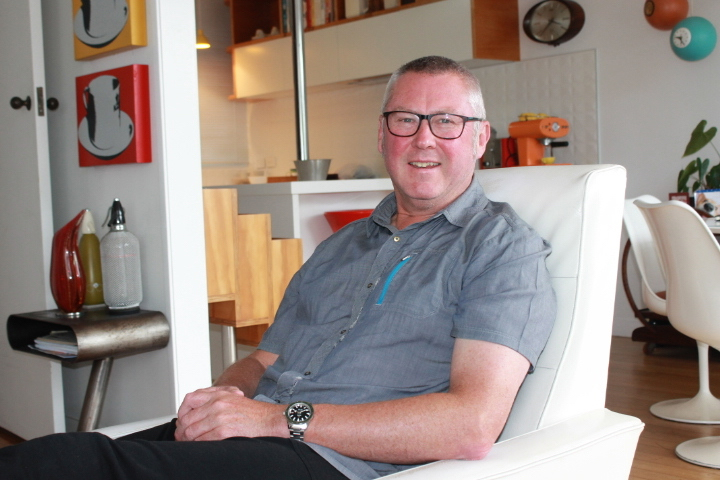
WF: For me it’s like so many things – the stuff at the edge is where the interesting things are. With exceptions. I’m a reasonably big fan of the Human League, who were the biggest pop band around for a while. But as a young fella I only ever bought what was current. I refused to go back and buy The Doors, or Pink Floyd – although I did break that rule once I was older, mid-twenties. We had a bunch of hippies at our school who would listen to Bad Company and The Grateful Dead and I used to think ’you tossers, there’s all this great music coming out’.
SN: I have to say I don’t own a single album of The Doors and I probably never will, and I despise Pink Floyd, so I suspect I’ll never own that either.
WF: “Despise”? Wow, is that a New Zealand perspective, or just a personal thing?
SN: Just a personal thing. I believe they are quite popular here, just never with me.
WF: Well well. Anyway – I came here to talk to you as a winemaker!! What are you doing at the moment?
SN: I’m quite busy – winemaking wise I’ve two clients I’m consulting for. A crowd in Gisborne called Lake Road Wines, and I look after their smaller volumes, higher-end. They’re a company that’s been set up to do bulk wine for cleanskin style stuff, but they, of late, wanted to do smaller runs of higher quality material, so I look after those for them. This year I’ve got a couple of Chardonnays and a couple of Pinot Gris that I’m looking after. That company has also bought Stanley Estate in the Awatere Valley. So I’ve had a look at all the Stanley Estate stuff for them as well. I think the deal was that the existing stock would be taken on consignment to see what they could sell.
WF: I’ve got reasonably high regard for Stanley Estate – their Chardonnay is something I’ve specifically bought in the past.
SN: Yes, I agree. And as far as I know it’s continuing as normal, so.. I suspect those guys were hunting for Marlborough Sauvignon and ended up with a bit of other stuff as a result of that purchase. So that’s one consultancy and the other is a North Canterbury property called Dancing Water Wines which is owned by a group of friends based up here. They wanted to invest in a project that had a meaningful, personal connection, and, they all loved beautiful wine.
Between the two of them, at this time of year, I’m pretty busy. They have a ten hectare property, four of which is planted, and if you are facing the property from the main road, just behind them on the right is Greystone, and behind them to the left is Mountford.
WF: I’m going to both those places next week when I’m in Waipara.
SN: To get to Mountford you have to drive alongside it. That’s taken up much of my time because it’s a rebuilding from scratch scenario, so there’s lots of input required there. And that’s a very interesting client to have. One of the partners is Kim Schofield. She is my primary contact. Kim is hugely motivated and they are making great progress.
WF: do you do the viticulture side of it as well?
SN: I do but that’s not my speciality. For both of my clients I do some viticulture though. Dancing Water have recently employed David Jordan as well, who you may have come across. He runs a company called ‘Vine to Wine to Market’ and he’s a viticulture specialist. He’s put in place some protocols for them, with a particular focus on the restoration of the vineyard.
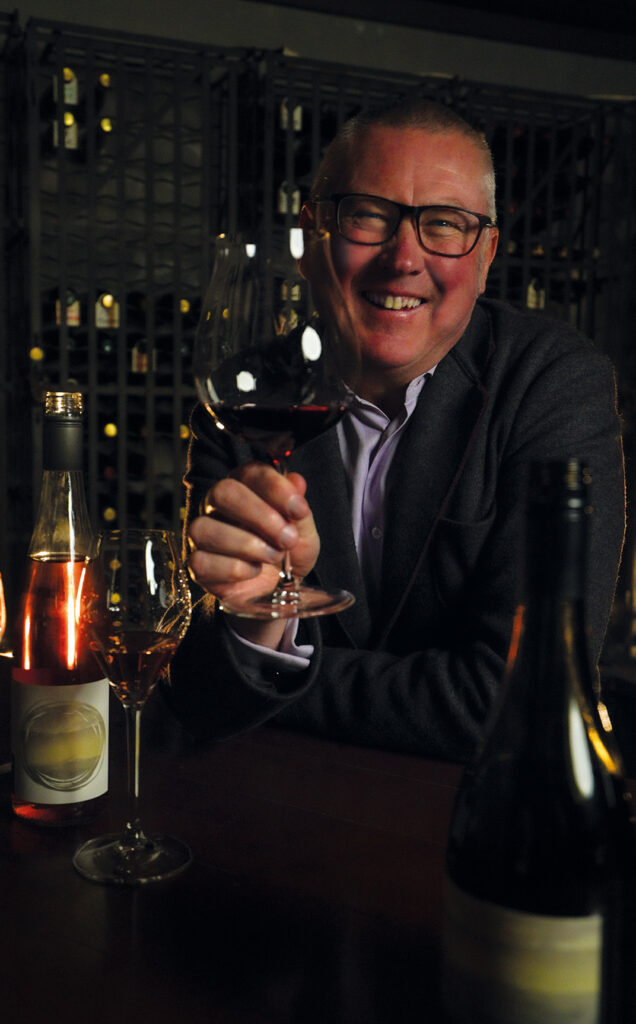
I can do day to day stuff, but when it gets a bit more serious like that I’m confident that there are plenty of people with greater ability than I. North Canterbury is a lovely spot, and although you could say ‘it’s got great potential’.. a lot of that potential is already being realised. There’s been some great wines coming out of there for a long time now. Dancing Water’s Pinot is their speciality and 2019 and 2020 wines are extraordinary. 2021, which has just gone into barrel, is also very, very flash.
WF: I’m very keen to go and have a look. That thing they’re doing at Greystone with the Vineyard ferment sounds interesting, and I’m going to Pyramid Valley and Bell Hill up the road as well.
SN: Those two clients will quieten down once vintage is over. And I’m making chutney still (laughs). I’ve been collecting guavas this morning. It’s a very bountiful guava year this year. You can use them for jelly, or paste or chutney. They’re challenging. It’s not a way to make your life easy. It’s very hard to get the stones out of them. I’ve also just got some persimmons and a bowl of limes. And Corey, the winemaker at Coopers Creek, got hold of a bunch of medlars. So I’ve got a couple of litres of medlar liquid (laughs) which I’ll find a way to use.
WF: I think people know I’m interested in flavours – food, tastes, and so on. People ask me fairly often about medlars!! And all I ever say is that it’s been a while since I dealt with any! You used to have to leave them to go soft basically – ‘blet’ them I think it was called.
SN: That is the appropriate term, yes! And you still have to do it. Corey was delighted when he found you had to blet them. It pretty much suits his personality style to leave them somewhere until they go rotten.
WF: I’m supposed to be going over there to see him at some point. I’d double booked myself, as I sometimes have an annoying habit of doing. So, how come you’re not still at Coopers Creek now?
SN: Well I left there in October 2019. That was almost 23 years there, which is a fair stint I think. Certainly I didn’t feel that I had the ability to achieve anything more than what I had. It was a good time to leave really. I’d made the decision middle of the year – June, I think, and gave them four months notice, which was plenty of time to find someone else. I was just tired, basically. A job like that you have to be on top of pretty much every situation and it’s ultimately very, very tiring.
WF: With some great plans for anything else?
SN: Not at all. I wanted to have a lie down, there was that. I’ve done something like 33 vintages, and I was certainly tired enough… without wanting to turn my back on what I’d done. Because that’s all I can do, really. The intention was to have a break. Then these two clients came to me – I didn’t actively seek other work. It’s interesting because Katrina, my partner, and I are in a lucky situation where this place is freehold, so we don’t have a mortgage. That allows you the ability to draw your horizons lower and closer, and live what can be a very fulfilling life on a whole lot less money.
WF: I’m lucky, I am still doing what I wanted to do as a career when I was seventeen. Back then I was really into published material – posters, magazines, things like record covers. Obviously the internet had changed the printed side of things, but online is still a very interesting connective way of communicating, and photos and words are still quite powerful. So, saying I wanted to get into publishing when I was 17.. it’s still really accessible to be in that environment now. So, I don’t know how many years you can say I’ve been doing that – over thirty – but I’m at a stage now where financially I can sleep happily at night. But I can now step off the hamster wheel and just indulge other interests. I didn’t focus on wine until about two years ago, when someone asked me ‘where I would like to be in ten years time’ type of question. So, I still find there’s lots of doors to open and have poke around in.
SN: Wait until you’re thirty or forty years into it and there’s still plenty of doors to be opened!
WF: is there something else that you would like to find time to do? Is there an itch to scratch?
SN: Not really, no. It might seem rather stupid but I’m quite comfortable doing what I’m doing at the moment. I’ve got an active role in the wine industry and that makes me happy, because it is a wonderful industry with any number of extraordinary human beings involved. It’s wonderful to be part of because you’re dealing with people who have so much knowledge and experience, and in most cases a willingness to share that. It’s funny because there’s so little proprietary knowledge – that is to say, that is specific to one person or organisation. Most of what goes on is published in scientific literature. There are few patented aspects of vinification that are genuinely known only to the patent holders, but beyond that pretty much everybody is able to know everything, which is wonderful.
We’ve changed our lifestyle so that our outgoings are much lower, and the income I have, in conjunction with Katrina’s, is enough to survive. She’s a winemaker by trade as well but she’s recently moved from Constellation Wines to the New Zealand Food Innovation Network. So the extra time I have has enabled me to get involved with chutney making, which seems like an odd thing to do perhaps, but in many ways it’s not.
WF: it’s an odd thing to say isn’t it? I mean you must see the reaction that goes across people’s faces every time you tell them, but… it sounds quirky! But people do all manner of quirky things, and I actually think it’s a pretty cool thing to do. I’ve got quite a library of books, and I’d say alongside things like foraging, wild food and self sufficiency books I probably do have about five books on Preserving Food. I have about ten different BBQing devices, and I used to have about the same number of gadgets for making coffee, for example. My maternal Grandmother was a Cook in a house not unlike Downton Abbey if you’ve ever seen that TV series. So properly old school kitchen prep. And I am quite obsessive about waste, and things like composting.
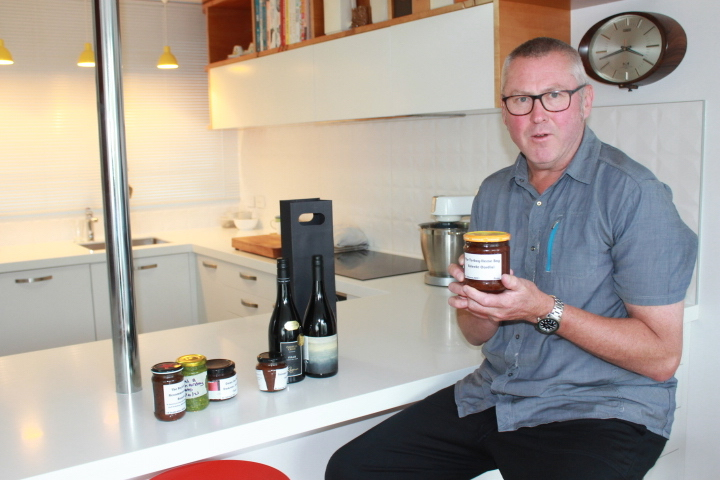
SN: I’m with you. I put out the weekly rubbish last night which was a bag about that big (shows me an imaginary bag that’s very small). And the whole chutney making thing is an extension of that in that in many ways. In the community there are so many people who have fruit trees and who aren’t willing or able to consume the produce. It doesn’t really take that long to start a series of contacts with local people who know that you are interested in having the guavas that are far more than they can deal with themselves, as was the case today. For example – olives. Last year was a big olive year in Auckland. I walk most days down through Herne Bay and the number of olive trees down there is extraordinary. You don’t have to work too hard to find people who really are delighted if you’re helping to remove the volume of fruit they’ve got in their backyard. And are similarly delighted when you take them a jar or two of chutney to say thank you.
WF: Are you someone who collects and cultivates weird and wonderful plants.
SN: Well, I’ll show you, in the garden at the moment there’s a Carolina Reaper, Scorpion, and a weird one with an Indian name I can’t remember.
(we go and look over Simon’s patch of garden)
WF: is that a Finger Lime?
SN: Yes, we thought we were going to get a fruit off it this year, but it fell off. So Finger Lime, Kaffir Lime, multiple chillis. That tallest plant there – that’s a Yakon – are you familiar with those? You dig them up and it looks like a kumara, but tastes like a cucumber crossed with a nashi pear. Sorrel – actually I’ve made some sorrel pesto and I’ll give you some.
WF: I have enough space at mine to be able to grow pretty much what I want – if I can. I don’t really see the point in growing stuff that I can easily get somewhere – like onions and potatoes, but I do grow spring onions for example and get through a lot of those. When we moved in I thought about what I wanted to plant, and that’s when the damson tree went in. Along with the right sort of citrus – limes, blood orange, figs, kaffir lime and so on.
SN: There’s a fig tree next door, and a mate round the corner’s got figs, and they both had a bountiful year. Interestingly, and I don’t really know why, but the bird pressure on the figs this year was the lowest in years. Normally you’d lose all of them to birds if you don’t net them.
WF: We get a heap of birds through the damsons but they’re so prolific it really doesn’t matter. We moved our fig tree about three years ago, so it’s still sulking a little.
SN: In the summer months there’s enough out there to keep us fully fed. There’s lettuce, rocket and tomatoes grow very well out there, and strawberries were really good this year.
WF: How did you get into wine – what got you started?
SN: The pathway for me was frightfully simple actually. My university first time around was at Massey University, which was, back then, a very ‘beer orientated’ experience and wine really didn’t get much of a look in. But my girlfriend of the time and I decided to go away for a long weekend together which we’d never done before. We had to get to Rotorua for a gathering with my family and we decided to go through Hawke’s bay and Gisborne and then on to Rotorua. I didn’t want to visit wineries, but she did. So I just gave up and went along. And even though I thought it would be a tremendously boring experience, it wasn’t. Went to Esk valley and Vidals, Eskdale, and up in Gisborne we went to Matawhero and possibly one other. So I went from knowing nothing about wine to suddenly being very interested.
I’d left university and I was working at a data processing company, and two of the people there were wine-orientated so they lent me books. The trip to these wineries was around April of 1987, and by about August I’d become fascinated by the diversity and history to the point that I wanted to become a winemaker. That was a relatively foolish thought in that I really didn’t know what a winemaker did, it just seemed like a fascinating thing. I was still living essentially a student lifestyle, although I had money now, so was able to buy some wine.
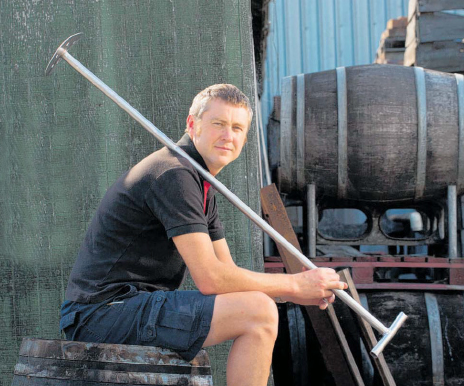
I moved from Palmerston North to Wellington with the same company who very kindly made me redundant in 1990 when the recession was biting fairly deep. By that stage my girlfriend and I decided we wanted to go to live in London, so while that was happening I got a job in a wine shop to fill that time in. It was a company called Tasman Wines and Spirits in Courtney Place in Wellington, which at that time was home to homeless and gluesniffers.
So we had a very steady clientele of some unique individuals who would be lined up outside the door at nine o’clock in the morning. We had fill-your-own fortifieds in the shop, so the clientele were diverse and unique.
Upon arrival in London I started to work as a fill-in person for Threshers who very kindly offered me a Managers position, and I said, thank you but No. I did apply for and got a job at Majestic Wine Warehouses though, and started to learn a bit more about wine. I worked there for most of the time I was in London.
It was a good job although we weren’t paid well, but had the opportunity to learn a lot. It helped me develop a global view, if somewhat Euro-centric, of wine.
Then I came back to New Zealand in 1992 and we went up to Auckland because it had better job prospects, and a wine industry. I started pestering people for a job, and by a strange quirk of fate I went out to Coopers Creek and had a chat to Kim Crawford, their winemaker. Kim and I went to the same high school, Matamata College.
This was October and he said ‘there’s nothing on but come and work vintage if you want’. Then after visiting, the Vineyard manager called and asked if I wanted to some work in the vineyard, so I became the ‘Tucker and Plucker’ at Coopers Creek Vineyard in 1992. Which was meant to be a two week job and lasted all the way through to vintage time, and then I was allowed to work in the winery for harvest. By then, in June, Villa Maria were advertising for cellar hands, and that was a fairly interesting experience.
They wanted two Cellar hands, one for Auckland and one for Hawke’s Bay. For that job they had 300 applicants, and I got the Auckland position and Rod McDonald got the Hawke’s Bay position, so Rod and I started our careers at the same time.
I worked the ‘94 vintage and then they allowed me to go to University at Lincoln to do a post grad diploma in 1995, which was a great year for our class. We had a very engaged group of people, and a lot of people who are still making wine. Claire Mulholland, Jackie Murphy, George Jerris, to name a few. It was a change of career for many, and we worked very hard. I went back to Villa Maria as an Assistant winemaker, then moved to Coopers Creek in ’97. That then went through to 2019!
And I did some vintages overseas as well. In 1996 I went to Oregon at Erath and that was a great experience. A very international group – people from France, South Africa, and lots of New Zealanders over there. I worked in Bordeaux in 2000 at a Chateau in St Emilion and I’ve done two harvests, in 2002 and 2004, in Burgundy at Chanson Pere et Fils. Overall a very, very worthwhile experience. It was a great learning time but also, as is always the case, a great life experience as well. The doing vintages overseas was very much part of my agreement with Coopers Creek, but in reality when you’re doing a job as busy as a winemaker’s job is there, after 2004 I just said ‘I can’t do this any more’. I was utterly exhausted after a huge vintage in New Zealand and then going overseas and working a month non-stop. I’d done my dash by then (laughs).
WF: Some wonderful wines came out of Coopers Creek though.
SN: Yes, I’m very proud of what we achieved. For a certain time there we had made some very wise vineyard-purchasing decisions. We were able to make some wines I was very proud of. And the other exciting thing with Coopers Creek was the fact that we were allowed to engage ourselves in new varieties in New Zealand, and much of that was through a single grower in Gisborne, Dave and Delwyn Bell. They planted Arneis early, so I probably made the first Arneis in New Zealand. I made the first Gruner Veltliner in New Zealand – that was through Paul Tietjen across the road. I wasn’t the first with Viognier but I was early with that. The first Albarino, the first Marsanne, the first Fiano. Arguably, although I’m not sure as Jenny Dobson may have beaten me there, the first LaGrein. The first Vermentino… so that was exciting times. Grape varieties that no one had any institutional knowledge of.
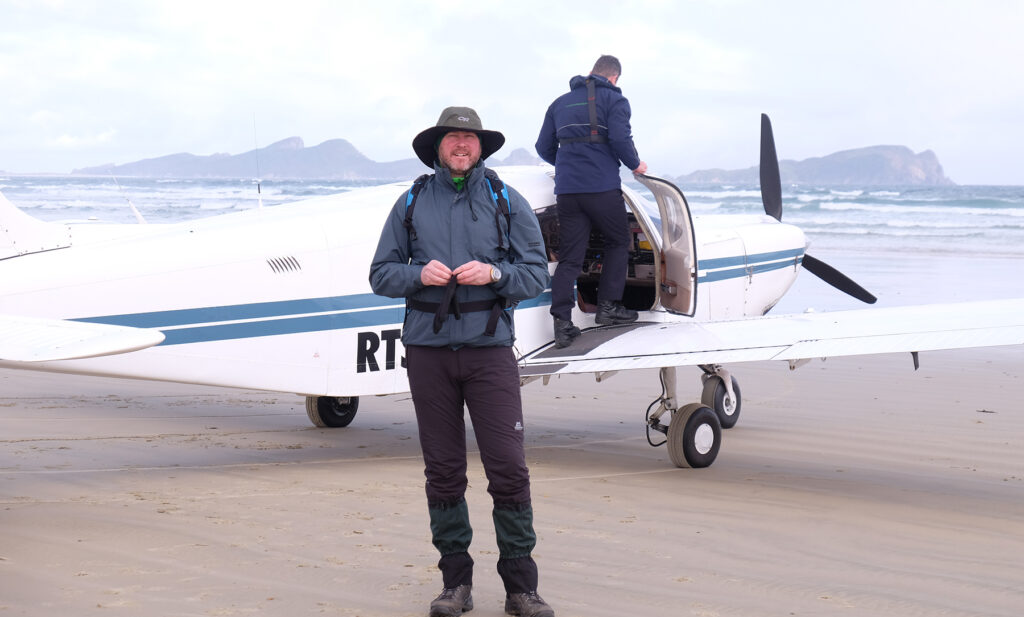
WF: That sounds like quite pioneering times? Did you have to reference examples from elsewhere to see what types of wines it would lend itself to?
SN: Albarino is fairly straightforward. Something like Marsanne is a much harder prospect, simply because in all the appellations it’s allowed, if it’s in a blend, and it’s not always, then they’re not necessarily going to tell you. A good deal of knowledge is required to ensure that you’re actually buying a wine that is just Marsanne as opposed to one which is a Roussanne-Marsanne blend. Flora and Vermentino are pretty easy. LaGrein not so easy in New Zealand but not impossible.
WF: Arethere other varieties that you wish you’d been a position to have a go at, in New Zealand? Like Pinot Noir for example?
SN: While it might not be immediately obvious, we made quite a bit of Pinot at Coopers Creek.
WF: OK, yes, let me re-phrase that. To have worked somewhere that you could be ‘known’ for making Pinot?
SN: Your question is quite interesting. You have to frame it in terms of my life view really. Katrina and I live here because we love living here. And Auckland is not the greatest place to grow grapes in the world. Certainly not the worst, but it’s not the best. And, we’re here because we love urban living. We lived up on Karangahape Road for five years in an apartment in the George Court Building, which we will most likely retire to at some point. We enjoy the multi-cultural nature of Auckland. We enjoy the level of diversity – in particular culinary. We both like food, a lot. I’m delighted to be able to easily shop in an Indian supermarket, a Chinese supermarket, a Filipino supermarket and a Middle-eastern supermarket which are all situated within a few minutes drive of one another.
So, in order to be become a specialist in something like Pinot would have required us to be willing to remove ourselves from Auckland, which we’ve never been willing to do. I would never say never, in so much as I don’t really know what the future holds, but I know I don’t really want to leave here. I can walk to Karangahape Road in three minutes and Ponsonby Road in just over five minutes. So there are real benefits to being here. And I understand that’s not the lifestyle that everyone desires.
If you are going to do anything in Auckland, then Chardonnay’s a very good bet. The wine industry in Auckland exists for historical reasons. Once the Dalmatians had stopped digging gum, they reverted to their ancestral strengths – fruit growing, market gardening and grape growing. And you may as well do that nearest the biggest population centre. In many ways the wine industry is slowly ebbing away from Auckland.
The opportunity for me to be a winemaker of specialist varieties didn’t really exist in Auckland. I want to be here, and the other reason I wanted to be at Coopers Creek was that it allowed me to do so many things. At one point we probably had 17 different grape varieties coming into the winery. There’s very few people who get to see that array of material and from such diverse sources. In essence, I enjoy the chance to live here and be close to the things I want to be engaged in.
WF: Coopers Creek undoubtedly made some excellent wines. What would you say are the stand outs?
SN: There’s a number of them really. There’s not one. Probably the most exciting from a commercial standpoint was the 2012 SV Albarino from Gisborne. That was the first commercial vintage we did.
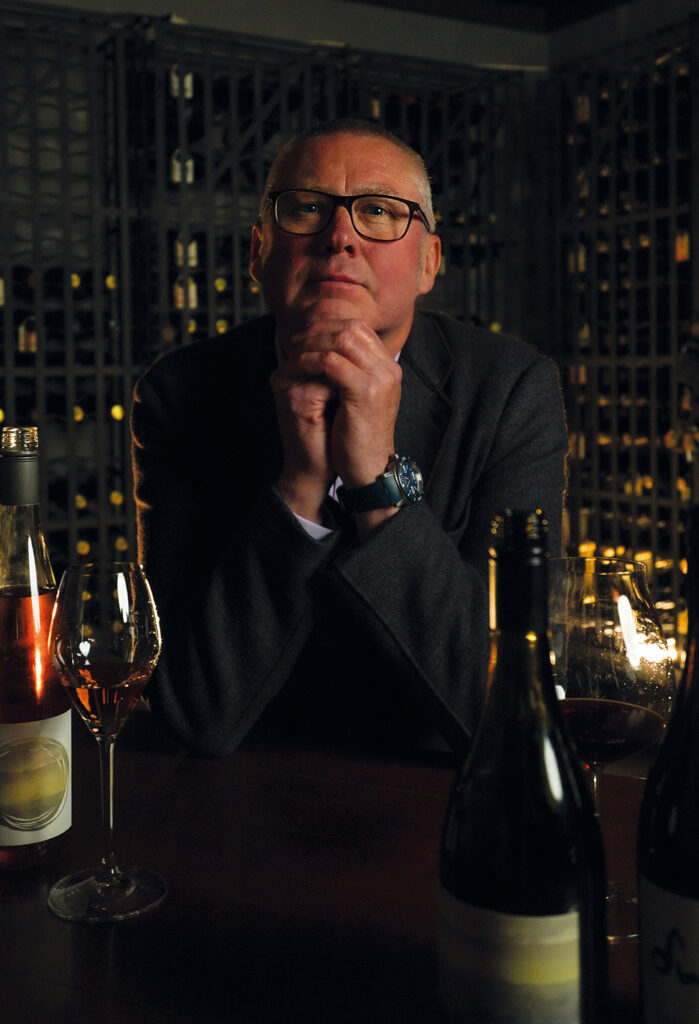
In 2011 we got 300kgs and I made one barrel – in fact I didn’t get the barrel full, I had to put some viognier in it to fill it up. Thankfully it was less than the 14% so we still called it Albarino. But in 2012 we got 9 tonnes, and that wine won seven gold medals and four trophies, possibly more than that. That was pretty exciting, there was a real roll – we won another gold medal, another trophy… Otherwise the wines that really stopped me in my tracks were the 2010 Reserve Syrah that we did off our Chalk Ridge Block. That still is a stonking wine, as is the 2013 off that block, as is the 2016 off that block…(laughs)
WF: I was at a tasting and had the 2013, and almost everybody who was at the tasting wanted to buy it – and although it was served, there wasn’t any for sale. We were gutted because it was such a great wine.
SN: I really rate that wine, but I rate the ‘16 and the ‘18 very highly as well.
WF: The Limeworks Chardonnay was in that new Hawke’s Bay Chardonnay box this year.
SN: Yes, the ’19 wasn’t it? That was a really good vintage. It was a funny one. The weather was relatively benign, so it was a great growing season, but in Hawke’s Bay there were two very large, unseasonal rain events. If you had the staff to do the hand work to deal with them you were fine. And if you didn’t – and we didn’t – you weren’t fine. So that was a very tough year. For that vintage I was flying down to Hawke’s Bay once or twice a week, and literally working in the vineyard. I wasn’t doing all the work, but certainly mowing, doing some spraying and stuff – and on Chalk Ridge as well, which is a very steep site. It was my job to be in the vineyard when it was harvested, and I was looking at it and I thought ‘this is going to be a pretty flash wine’. Limeworks is designed to be ‘on special’ for under $20, and you get a fair bit of wine for your dollar.
WF: I was sent the box and I thought it represented Hawke’s Bay Chardonnay very well. I assume that Cameron Douglas was looking for a range, rather than just picking the dozen that were his personal preferred style. Because as well as the Limeworks, I was pleased to see a label like Monowai in there too.
It’s odd because I went to a public ‘Hawke’s Bay’ tasting recently, and I was a bit taken aback at how unrepresentative of today’s Hawke’s Bay it was. It was as if the person who’d picked the wines hadn’t been to Hawke’s Bay for twenty years! Two thirds of the wines served were from Te Mata, Church Road, and the Villa Maria Group. And comments like “well, there’s not much new coming out of Hawke’s Bay” had a few of us shaking our heads in disbelief. Those brands are all excellent, but I think there’s quite a renaissance in smaller producers, many without Cellar Doors, making some really good wines. If it was me I’d have definitely included The Supernatural, Decibel and Helio at least – for example, maybe Zaria and Halcyon Days too if I thought I could.
SN: Yes I agree with that. It’s a wonderful winemaking community in Hawke’s Bay.
WF: I wanted to ask you about judging as well. That was my first go at that, in February, and I guess I’ve always just looked at wines and thought well do I like that or not, and taken a very ‘consumer’ type approach to it. Hopefully a very well informed consumer, but not a winemaker’s, or even a ‘trade’ approach to it. There appears to be a camaraderie to it that’s more than just the kudos of “being a judge”?
SN: I can give you my view. The wine industry, willingly or otherwise nurtures the individual – me, the winemaker – so it’s important to return that favour and nurture the industry. If you can help to improve things that’s very important to do that, I believe. There’s that aspect of it. Then there’s the educational aspect of it – the more you taste, the more you learn.
Also, you’re catching up with your mates, which is a really important thing. I alluded to that earlier on. The production end of the wine industry is so open and collegial. People will openly and willingly answer questions if you’ve got them. Or give advice if you request it. Winemakers in general from our part of the world, just by default, are reasonably worldy-wise individuals. Most people have worked multiple times in another country. Most people have at least a degree of interest in the things that wine brings with it. Food, mythology, history, art, architecture – all of those things.
It allows you to immerse yourself in people who are not only very talented at what they do, but are usually interested in food. It’s rare to encounter “oh I don’t eat that” and the same from a vinous perspective. They’ll happily engage in whatever appears.
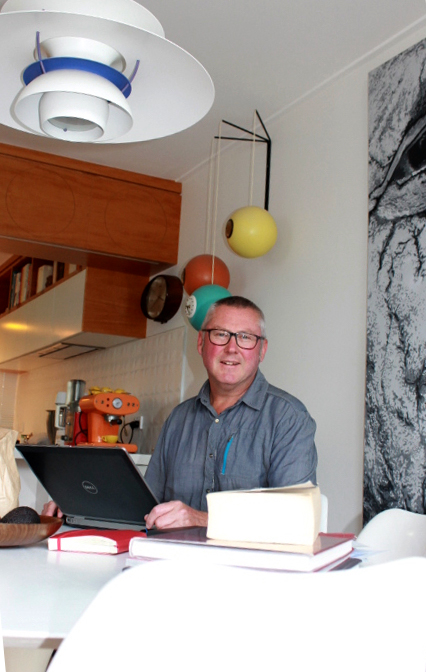
So, associated with that we do have some fabulous meals. And get to try some really fabulous wines that people bring along. That’s the good thing about winemakers – everyone is willingly coughing up wines which in some cases are worth hundreds, if not thousands, of dollars a bottle. A chance to taste things you wouldn’t normally, and learn about them.
WF: I think it’s a love of flavour – in all it’s meanings. Not just in wine, but in life.
SN: It’s a thirst for flavour and for knowledge as well. Wine people in general like to learn.
WF: And do you think the Show system works well?
SN: Yes, broadly speaking, I think it does. That’s a question in this form that we can’t really answer as in many ways it requires a doctoral thesis to cover all aspects of it.
There are a number of good reasons to criticise show judging and a number of good reasons to praise it as well. Wine shows by their very nature will often, willingly or otherwise, exclude people who are really on the fringes of what is acceptable. So if you’re doing things which are a bit odd, or in a way that’s a bit odd, or using grape varieties that are not necessarily going to achieve great success in the Wine Shows, you need to think of a different path to market. Wine Shows are not the be-all and end-all, but they are part of the matrix.
In terms of what you’re doing – wine is my life and my future. Everyone who is helping wine be viable, and that’s not just a particular type of wine – I’m talking about wine overall – is essentially a valuable part of what we all want to achieve. So, if you were known to be profoundly anti and contrary, I would be not so happy about that. But anyone who strives to educate and enlarge the world that we live in…
WF: When I started out I was mentored by a couple of people who advises me along the lines of ‘be honest’ and ‘find the good in things’. People like Raymond Chan, I felt had that sense of positivity in what he was doing, whilst making the subject matter easily understood. Also, he didn’t seem to approach it as being very much about himself? Also, whilst it might be entertainment to publish a damning review of something, it’s probably not much of a long term strategy. I’ve done a couple of interviews in the last year, where I’ve returned to the subject afterwards and made it clear that whilst I could very well just publish what they said at the time – that it’s probably not in anyone’s interests that I do – and that gets edited out.
SN: Exactly what you said – panning a winery or a person… it’s better to just say nothing. However, if you cast your mind back. Historically, in New Zealand at least, we’ve used the 20-point system. The full system is almost never used. It’s very rare to score a wine lower than thirteen in that 20-point system, but at least we understand the hierarchy. Then the US system, and Robert Parker, were the driver of that 100-point system. By default that has become increasingly utilised in our environment as well. And of course the tricky thing is trying to match one with another. A magnificent Gold medal-winning wine gets, say 19 points – so that extrapolated out to 100 points is 95. And a really good wine – a Bronze Medal wine gets 15.5 points. Extrapolate that out, and that’s 77 and half or something? Using the American system, no-one’s going to buy that wine. So we have been forced, unwittingly really, to squeeze what you’ve got into what you’re going to use. Essentially in the 100-point system you’re looking at 85 and above.
WF: What are your thoughts on 100-point wines? The perfect wine.
SN: I’ve never had a wine that I consider perfect. But I’m also aware that my ability to access those sort of wines…(laughs) The closest wine I’ve probably had to perfection is a Penfolds Bin 60A – one of the very few bottles still in existence – and that was a 1962 vintage I think. A Coonawarra Cabernet – Kalimna Estate Shiraz, and that was given to someone who worked with Max Schubert. I had that a couple of years ago and that was, for me, the most extraordinary wine I’ve ever had. But I think even in that case I wouldn’t think it would score 100 points. If you’re being absolutely objective, there’s always something that’s not quite right. I’m not a wine critic, so there’s no social requirement for me to score a wine 100 points and in reality I probably never would.
WF: it’s certainly a part of my career that I feel is perhaps the most difficult. I mean, how do you get the skillset to be able to say that anything is ‘perfect’?
SN: Of course the thing to remember is that if a wine is scored 100 points, it’s invariably by an individual journalist. I don’t recall ever hearing of a 100 point scoring wine which has come from a judging collective. That’s the way that being an individual wine critic works. And also why in many ways, judging is a wonderful alternate to that. In that no-one has the perfect palate. Everyone has strengths and everyone has weaknesses. So if you have a judging panel of three strong judges, there will be a series of strengths and weaknesses amongst those three. So there’s a reasonable chance that if there’s a 100-pointer in the line-up, it’s not going to be missed.
WF: I wrote something about ‘cult wines’ – any thoughts on that? What makes a wine, a ‘Cult’ wine?
SN: Cult wines in what sense?
WF: There seemed to be a consensus that the main factor would be a difficulty in getting hold of it, and that could be price-related but not entirely… maybe it’s scored 100 points?
SN: Again, I think a doctorate thesis is required, but I’ll answer in my own way. You can view it in many ways I think. You can view it from the Robert Parker view, and look at Barossa Valley Shiraz – so, Barossa Valley floor, old vines, very low crops, very low yielding, but with everything thrown at it. Wines that are black, with masses of tannin, masses of alcohol. Very ripe – which is a characteristic that Robert Parker and his contemporaries like. But in many ways should not necessarily be viewed as what the Barossa Valley can do. The volume has been turned up to the point where the ability to easily detect the grape variety has gone. The ability to easily detect where it’s from is gone. The ability to detect that it’s got a lot of oak is present. Influential critics have enjoyed that and scored it highly – so that’s one way to ‘Cult’ status, and that can become even more Cult-like if a wine is hard to come by, or a wine is extraordinarily expensive.
The other way of looking at Cult wines is that wines that appeal to a particular sub-set of humanity. Now, more and more, so we are seeing mostly young folks are taking a slightly different path to market. They’re making wines that appeal to them, but also making wines that appeal to a group of the wine-drinking population, some of which might be quite small. But if those people are appropriately engaged, the wine can become a Cult wine. And it may not be a wine that Mr Robert Parker and his contemporaries look fondly upon. But it is enormously relevant to the people who want to consume it.
Ultimately there’s space for everybody in the room, but not everybody likes the same thing, and you only have to look at through my record collection to understand that. And I’d be dismayed if everyone was required to like the same thing. The important thing about happiness during our time on Earth is to engage yourself in the things that make you happy, not the things that make other people happy.

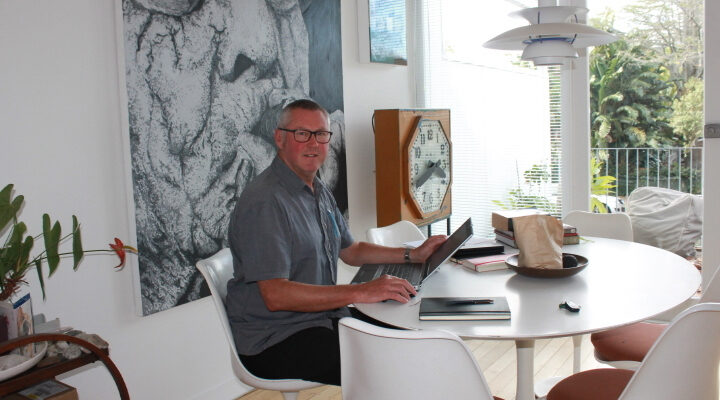


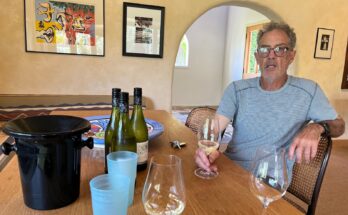
One Comment on “Winemaker series: Simon Nunns”